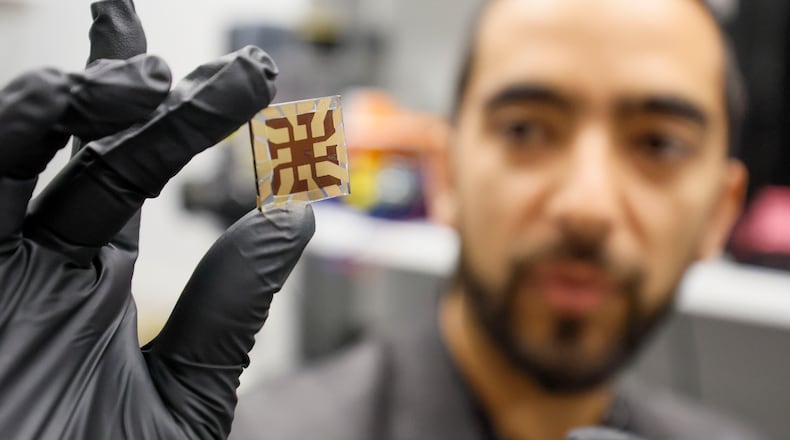Beneath a maze of tubes, Leonardo Josué Lugo Salas focused intently on the postage stamp-sized piece of glass he was clutching between a pair of tweezers.
Reaching his arm through a rubber glove and into an airtight box, Salas, a visiting graduate student at Georgia Tech, carefully deposited a few drops of a bright yellow liquid on the glass' surface. After placing the square in a machine to spin it and even the coating, he transferred it to a hot plate, watching as the yellow film on top turned black in a matter of seconds. Later, it will be affixed with strips of real gold to create a cluster of eight tiny, but functional, solar cells.
The solar chips being produced at Georgia Tech still need to be scaled up dramatically to compete with ones made with silicon, the industry standard. But the lab’s leader, associate professor Juan-Pablo Correa-Baena, said the materials they are developing could help revolutionize the solar industry, break China’s grip on the sector and create manufacturing jobs in the U.S.
Credit: Miguel Martinez-Jimenez
Credit: Miguel Martinez-Jimenez
The key ingredient in his team’s research is a family of compounds called perovskites.
Perovskites are found throughout the Earth’s crust and are known for their distinctive crystal structures, though the ones found in nature are not effective at absorbing light, Correa-Baena said. But in labs like this one and others, researchers have figured out how to bind different elements and molecules together to mimic their crystal formations, producing materials that can capture the sun’s rays.
Nearly all modern solar panels are made with silicon, apart from a small slice of the market that uses cadmium telluride technology.
Silicon solar panels are very good at their job. They are efficient at capturing solar energy, durable and have gotten much cheaper over the last decade-plus. Many are made here in Georgia at two massive factories in the northwest part of the state owned by Qcells, a Korean solar manufacturing giant.
Credit: Steve Schaefer /
Credit: Steve Schaefer /
But there’s still room for improvement, Correa-Baena said. That’s where perovskites come in.
The ultrapure silicon in today’s panels requires lots of energy and factory space to produce. In perovskite solar cells, Correa-Baena and many other researchers see potential for alternative materials that “don’t need this level of purity, but have the same performance.”
The payoff, he said, would be cheaper panels that can be produced in facilities without astronomical price tags and space needs. And if the U.S. can lead the way in developing the new technology, it would give the industry a new foothold to bring solar manufacturing back from China, which dominates the silicon-based supply chain.
Last year, the British company Oxford PV delivered units of its perovskite-silicon solar panels to a U.S. company, in what the company says was the “first commercial distribution of perovskite tandem solar panels.”
Credit: Miguel Martinez-Jimenez
Credit: Miguel Martinez-Jimenez
Still, there is work to be done before perovskites are ready to play a major role in the global solar market. Where they lag compared to their silicon competitors is in their longevity and durability, Correa-Baena said
“We won’t be able to deploy them on roofs or in fields if we don’t have a solar cell that lasts for more than three years,” he said.
On top of experimenting with ways to boost panel stability, Correa-Baena’s lab is exploring new methods for applying perovskite films to solar chips.
Credit: Miguel Martinez-Jimenez
Credit: Miguel Martinez-Jimenez
His group has also applied for multiple patents, including one in collaboration with a solar manufacturer, whose name he said he could not disclose because of trade secret concerns.
Georgia Tech’s lab is not the only group looking at perovskite technologies. There are thousands of other academic and private research outfits working to innovate in this space, Correa-Baena said.
All that work means it might not be long before perovskites are ready to play a bigger role helping the world meet its energy needs.
“My crystal ball tells me that in about five years, it’s going to be real,” he said.
A note of disclosure
This coverage is supported by a partnership with Green South Foundation and Journalism Funding Partners. You can learn more and support our climate reporting by donating at AJC.com/donate/climate.
About the Author
Keep Reading
The Latest
Featured







